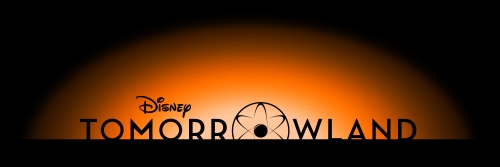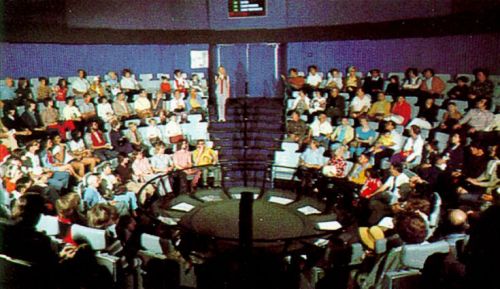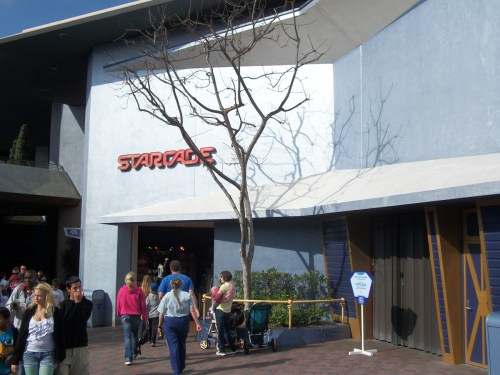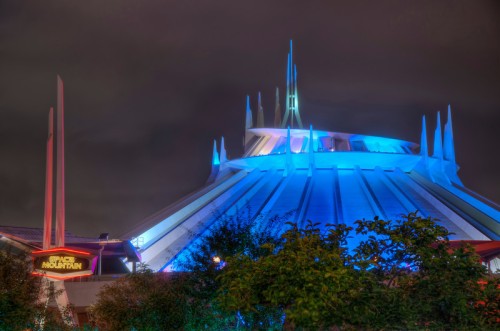Note: In celebration of Disney’s Tomorrowland opening in theaters on May 22, Quest for Vault Disney is taking a decade by decade look at Disneyland’s Tomorrowland. In Part 1 we looked at Disneyland’s Tomorrowland as it stood on Opening Day, July 17, 1955. Part 2 looked at the evolution and development of the land from July 18, 1955 through the end of calendar year 1964, while Part 3 looked at the ten years of 1965 through 1974. Here is a look at the ten year period between 1975 and 1984.
It’s worth noting this was a slow period of growth in Tomorrowland. A major remodel had just taken place at the end of the 1960s to being Tomorrowland “up to date”, while other areas of the park were in need of attention. In Frontierland, a big thunderous mountain was forming in the late 1970s, while Fantasyland was going through a major remodel/redesign in the early 1980s, pulling resources away from Tomorrowland.
That’s not to say there were no additions to Tomorrowland. In fact, keeping with the theme of the area, everything that opened in this area was out of this world, so to speak. First to open, on March 21, 1975, was Mission To Mars. Launching from the same pad that once housed Rocket to the Moon and more recently Flight to the Moon, the Mission to Mars attraction was sponsored by McDonnell-Douglas, as Flight to the Moon had been. Guests would enter Mission Control, where they were greeted by audio-animatronic Mr. Johnson, a mechanical scientist, who gave a mission briefing before sending passengers to their seats in the flight theater. There, two large screens, one on the ceiling and one of the floor showed guests where they were headed and had come from, respectively as they headed to the Red Planet. Thanks to a hypersleep, the journey to Mars and back only took 15 minutes to complete. Despite low attendance figures to due to a waning of space exploration interest, the attraction lasted until 1992 before being shuttered.
Two years later Tomorrowland would see the arrival of a much more thrilling space attraction, and to prepare for it, the area where the Flying Saucers had previously existed was given a more intergalactic feel. First, in the same show building as Mission to Mars came Space Place, a large counter service restaurant for guests to grab some pizza or hot dogs. Space Place had the distinction of being the only eatery in Disneyland to serve both Coca-Cola and Pepsi Cola at the same time (Coke and Pepsi were both available in the park, just not in the same location, typically). The restaurant itself would serve guest until 1996, when it was closed to make room for a new, temporary attraction that was also taking the space used by Mission to Mars.
At the same time, another quick service eatery, Lunching Pad opened directly below the second story PeopleMover boarding area. Hot dogs, popcorn and sodas were available in this spot, which previously housed the Space Bar. While popular for a quick bit for guest in a hurry, the Lunching Pad would last until a major remodel of Tomorrowland in 1998.
As part of the 1977 expansion, a new technology opened in Tomorrowland on May 4. Starcade, a two story video game arcade (unrelated to World Championship Wrestling). Park guests, who had already paid an admission just to be in Disneyland, were able to plug quarters into the newest video games on the market. As the technologies improved, so did the games (and prices), including ski simulators and huge multi-player racing simulators. The Starcade is still open, though now it is only a one story arcade instead of two, with top of the line games costing $4 per play.
As exciting as a video arcade or some quick service food eateries are, the star of Tomorrowland’s 1977 expansion was Space Mountain, Disneyland’s first indoor roller coaster. It’s worth noting this Space Mountain not the first in the Disney Universe, as the coaster opened in Walt Disney World in 1975. Space Mountain would be the second of the Disneyland Mountain Range, behind Matterhorn, and two years prior to Big Thunder Mountain in Frontierland, and Splash Mountain in the yet-to-be-imagined Critter Country (1989). The attraction, built over the Flying Saucers flight path, soared 118 feet in the air, the second highest structure in the park (Matterhorn Mountain, at 147 feet is the highest). It was intended to draw park guest away from the competing theme parks in the area (Magic Mountain and Knott’s Berry Farm specfically). Mission accomplished, as more than ten million park guests came into the park to experience the “pitch black”, 30 mile per hour thrill ride. When the ride opened, it was a “silent” roller coaster, that is, the only sounds were the rocket shaped cars on the track and the screams of the riders. In 1997 enhancements were made to the cars, with speakers being installed to pipe in a music soundtrack. The attraction, with its 1800 guests per hour capacity, is still in operation today.
As mentioned in the opening that 1975-1984 was a slow period of growth. After the 1977 expansion, there were no additions to Tomorrowland until 1986, and those will be covered in Part 5. I thank you for taking the time to read this today. I ask you would please leave comments. You may contact me directly on Twitter @Quest4VaultDisn, and you may also subscribe to be alerted by email when new postings are published. Quest for Vault Disney is now on Facebook. Please visit https://www.facebook.com/groups/questforvaultdisney. Have a great rest of your day. See ya real soon…








[…] Great Big Beautiful Tomorrow(land) Part 4 […]
[…] For glimpses of the area in past decades and opening day, be sure to look at Parts 1, 2, 3, 4, and […]
[…] Great Big Beautiful Tomorrow(land) Part 4 […]